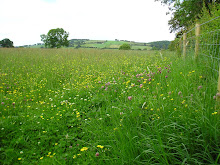
Reading back in this blog I realise that it has become a bit of an "anorack's diary" so its time to lighten up.
Following a rush of blood to the head we now have a new Labradoodle puppy. On Wednesday she was out by our pond with Jacqui. Unfortunately so were a good number of our honey production team collecting water needed in the hive. Ruffle being an inquisitive 9 week old, was fascinated by the buzzing sound in the shallows and headed straight in to check it out. Bees' worst enemy are bears that tend to be big, dark, and furry so a worker is programmed to defend the colony by burrowing into the fur to sting. Seeing a worker on top of Ruffle's head Jacqui selflessly grabbed the bee with her hand and removed it but of course got stung in the process. Fortunately she knew to scrape the sting away with her fingernail so that the pulsing sack of venom was quickly removed and the pain quickly subsided. Not everyone is aware that, despite being torn from the dying bee's body, muscles attached to the sting will continue to pulse for up to 20 mins driving yet more venom into the victim. Hence quick removal is a good idea!
Only a wife and a bee were hurt in the making of this story, Ruffle was entirely unharmed and, it has to be said, unconcerned.



